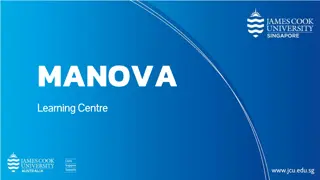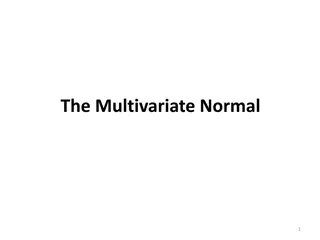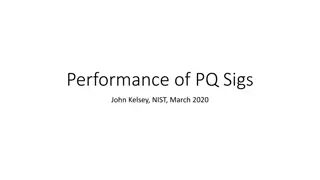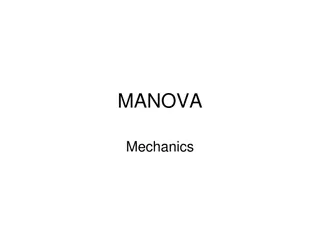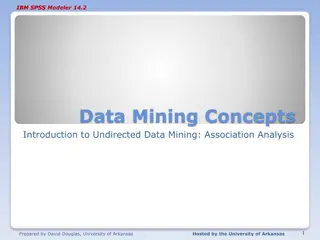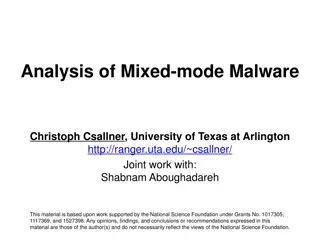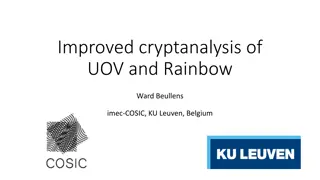Algorithm Analysis
Algorithm analysis involves evaluating the efficiency of algorithms through measures such as time and memory complexity. This analysis helps in comparing different algorithms, understanding how time scales with input size, and predicting performance as input size approaches infinity. Scaling analysi
1 views • 30 slides
Market Analysis (Project Formulation)
This detailed guide covers essential aspects of market analysis and project formulation in entrepreneurship, including feasibility analysis, techno-economic analysis, market demand analysis, steps in market analysis, and factors to consider for market demand analysis. Explore how to assess market de
2 views • 30 slides
Static Analysis Techniques Overview
Explore static analysis techniques such as syntactic analysis, dataflow analysis, and model checking. Understand the concept of basic blocks in static analysis and their boundaries. Dive into the opportunities provided by static analysis in summarizing program behavior without executing it.
9 views • 27 slides
Multivariate Analysis
Explore the key concepts of marginal, conditional, and joint probability in multivariate analysis, as well as the notion of independence and Bayes' Theorem. Learn how these probabilities relate to each other and the importance of handling differences in joint and marginal probabilities.
5 views • 43 slides
Bioinformatics for Genomics Lecture Series 2022 Overview
Delve into the Genetics and Genome Evolution (GGE) Bioinformatics for Genomics Lecture Series 2022 presented by Sven Bergmann. Explore topics like RNA-seq, differential expression analysis, clustering, gene expression data analysis, epigenetic data analysis, integrative analysis, CHIP-seq, HiC data,
0 views • 36 slides
Comprehensive Cost Management Training Objectives
This detailed training agenda outlines a comprehensive program focusing on cost management, including an overview of cost management importance, cost object definition, cost assignment, analysis, and reporting. It covers topics such as understanding cost models, cost allocations, various types of an
2 views • 41 slides
Understanding Multidimensional Scaling and Unsupervised Learning Methods
Multidimensional scaling (MDS) aims to represent similarity or dissimilarity measurements between objects as distances in a lower-dimensional space. Principal Coordinates Analysis (PCoA) and other unsupervised learning methods like PCA are used to preserve distances between observations in multivari
2 views • 21 slides
Qualitative Data Analysis Techniques in Research
The purpose of data analysis is to organize, structure, and derive meaning from research data. Qualitative analysis involves insight, creativity, and hard work. Researchers play a crucial role as instruments for data analysis, exploring and reflecting on interview discussions. Steps include transcri
1 views • 27 slides
Understanding Multivariate Binary Logistic Regression Models: A Practical Example
Exploring the application of multivariate binary logistic regression through an example on factors associated with receiving assistance during childbirth in Ghana. The analysis includes variables such as wealth quintile, number of children, residence, and education level. Results from the regression
0 views • 19 slides
Parallel Implementation of Multivariate Empirical Mode Decomposition on GPU
Empirical Mode Decomposition (EMD) is a signal processing technique used for separating different oscillation modes in a time series signal. This paper explores the parallel implementation of Multivariate Empirical Mode Decomposition (MEMD) on GPU, discussing numerical steps, implementation details,
1 views • 15 slides
Understanding MANOVA: Multivariate Analysis of Variance
MANOVA, an extension of ANOVA, deals with multiple dependent variables simultaneously to test mean differences across groups. Types of MANOVA include one-way between/within subjects and mixed MANOVA. An example explores the effects of coffee consumption on anxiety and fatigue levels. SPSS data files
1 views • 33 slides
Understanding Multivariate Normal Distribution and Simulation in PROC SIMNORM
Explore the concepts of multivariate normal distribution, linear combinations, subsets, and variance-covariance in statistical analysis. Learn to simulate data using PROC SIMNORM and analyze variance-covariance from existing datasets to gain insights into multivariate distributions. Visualize data t
0 views • 16 slides
Performance of Post-Quantum Signatures: Analysis and Comparison
Explore the performance and characteristics of various post-quantum signature schemes including Lattice-based Dilithium, QTesla, Falcon, Symmetric Sphincs+, Picnic, Multivariate GEMSS, Rainbow, and more. Understand the implications of using these schemes in TLS, code signing, firmware updates, signe
0 views • 29 slides
Optimization Methods: Understanding Gradient Descent and Second Order Techniques
This content delves into the concepts of gradient descent and second-order methods in optimization. Gradient descent is a first-order method utilizing the first-order Taylor expansion, while second-order methods consider the first three terms of the multivariate Taylor series. Second-order methods l
0 views • 44 slides
Understanding MANOVA: Mechanics and Applications
MANOVA is a multivariate generalization of ANOVA, examining the relationship between multiple dependent variables and factors simultaneously. It involves complex statistical computations, matrix operations, and hypothesis testing to analyze the effects of independent variables on linear combinations
0 views • 16 slides
Introduction to Data Analysis in Geophysics with Seismic Analysis Code - SAC Lab 2.1
Explore the world of geophysics data analysis using the SAC Lab 2.1 code. Learn about seismic analysis, Fourier transform analysis, spectral analysis, color tracing, integration, differentiation, and more. The SAC online documentation provides valuable resources for users to delve deeper into this f
0 views • 45 slides
Determinants of Growth in Micro & Small Enterprises: Empirical Evidence from Jordan
Jordanian micro and small enterprises (MSEs) play a significant role in the economy but face challenges in accessing markets and obtaining finance. A research study was conducted in Jordan to analyze the factors influencing the growth of MSEs, including formality, education level of owners, technolo
0 views • 8 slides
Rainbow Signatures Overview and New Attacks
Rainbow signatures, introduced in 2005, offer good performance with small signatures but raise concerns due to large key sizes. This article explores the history of Rainbow, its vulnerabilities, new attacks, and the challenges posed by multivariate trapdoors. The overview delves into practical impli
0 views • 20 slides
Data Analysis and Passage Analysis Project Proposal
This project proposal by Anthony Yang focuses on developing a Java program for data analysis and passage analysis. The motivation behind the project is to gain more knowledge in computer science and statistics-related topics while utilizing technology to extract useful insights from data. The propos
0 views • 8 slides
Efficiency Methodological Approaches in Prisons Service Quality Study
Exploring efficiency methodologies in analyzing prisons service quality, this study focuses on parametric and non-parametric approaches such as Data Envelopment Analysis (DEA) and Stochastic Frontier Analysis (SFA). It delves into benchmarking techniques, productivity analysis, and the implications
0 views • 21 slides
Statistical and Quantitative Genetics of Disease
This session covers single locus analysis in statistical and quantitative genetics, focusing on design, analysis, logistic regression, covariates, and multivariate analysis. It discusses approaches for analyzing DNA on cases and controls, modeling, and adjusting for covariates. The association analy
0 views • 36 slides
Understanding Multivariate Statistics: Regression, Correlation, and Prediction Models
Explore the differences between regression and correlation, learn about compensatory prediction models, understand the role of suppressor and moderator variables, and delve into non-compensatory models based on cutoffs in multivariate statistics.
0 views • 9 slides
Limits on the Efficiency of Ring LWE-based Key Exchange
This study explores the limitations of Ring LWE-based key exchange protocols and their impact on non-interactive key exchange mechanisms. It discusses the LWE assumption, noise distribution, and the practical implications of small moduli q and noise-to-modulus ratio r. Additionally, it delves into P
0 views • 71 slides
Understanding the Relationship Between Cost Benefit Analysis and Financial Analysis
The intersection of cost benefit analysis and financial analysis is crucial for evaluating projects, with economic analysis focusing on incremental benefits and costs while financial analysis ensures sustainability. Perspectives like those of the government, utility manager, and private lender shape
0 views • 8 slides
Lower Bounds for Small Depth Arithmetic Circuits
This work explores lower bounds for small-depth arithmetic circuits, jointly conducted by researchers from MSRI, IITB, and experts in the field. They investigate the complexity of multivariate polynomials in arithmetic circuits, discussing circuit depth, size, and the quest for an explicit family of
0 views • 114 slides
Introduction to IBM SPSS Modeler: Association Analysis and Market Basket Analysis
Understanding Association Analysis in IBM SPSS Modeler 14.2, also known as Affinity Analysis or Market Basket Analysis. Learn about identifying patterns in data without specific targets, exploring data mining in an unsupervised manner. Discover the uses of Association Rules, including insights into
0 views • 18 slides
Introduction to Static Analysis in C.K. Chen's Presentation
Explore the fundamentals of static analysis in C.K. Chen's presentation, covering topics such as common tools in Linux, disassembly, reverse assembly, and tips for static analysis. Discover how static analysis can be used to analyze malware without execution and learn about the information that can
0 views • 54 slides
Understanding Transactional Analysis in Human Relationships
Transactional Analysis (TA) is a method developed by Eric Berne to analyze communication between individuals. It helps in understanding human relationships by categorizing interactions into different ego states like ID, Ego, and Super-Ego. TA provides valuable insights into personalities, aids in re
0 views • 52 slides
Comprehensive Credit Analysis Process for Risk Management
Explore the credit analysis process for effective risk management, covering aspects such as requested amounts, profitability analysis, collateral analysis, industry analysis, and both quantitative and qualitative analyses. Learn about the key parameters considered in establishing internal ratings an
0 views • 45 slides
Industrial, Microbiological & Biochemical Analysis - Course Overview by Dr. Anant B. Kanagare
Dr. Anant B. Kanagare, an Assistant Professor at Deogiri College, Aurangabad, presents a comprehensive course on Industrial, Microbiological, and Biochemical Analysis (Course Code ACH502). The course covers topics such as Industrial Analysis, Microbiological Analysis, and Biochemical Analysis. Dr. K
0 views • 16 slides
PySAT Point Spectra Tool: Spectral Analysis and Regression Software
PySAT is a Python-based spectral analysis tool designed for point spectra processing and regression tasks. It offers various features such as preprocessing, data manipulation, multivariate regression, K-fold cross-validation, plotting capabilities, and more. The tool's modular interface allows users
0 views • 6 slides
Analysis of Mixed-Mode Malware and Malware Analysis Tools
This analysis delves into mixed-mode malware, detailing its two phases and potential impact on malware analysis tools like TEMU. It explores scenarios where malware attacks analysis tools, emphasizing the challenges faced in observing and preventing malicious behavior. The study also highlights vari
0 views • 14 slides
Benefits of Probabilistic Static Analysis for Improving Program Analysis
Probabilistic static analysis offers a novel approach to enhancing the accuracy and usefulness of program analysis results. By introducing probabilistic treatment in static analysis, uncertainties and imprecisions can be addressed, leading to more interpretable and actionable outcomes. This methodol
0 views • 11 slides
Understanding Multivariate Adaptive Regression Splines (MARS)
Multivariate Adaptive Regression Splines (MARS) is a flexible modeling technique that constructs complex relationships using a set of basis functions chosen from a library. The basis functions are selected through a combination of forward selection and backward elimination processes to build a smoot
0 views • 13 slides
Quasi-Interpolation for Scattered Data in High Dimensions: Methods and Applications
This research explores the use of quasi-interpolation techniques to approximate functions from scattered data points in high dimensions. It discusses the interpretation of Moving Least Squares (MLS) for direct pointwise approximation of differential operators, handling singularities, and improving a
0 views • 9 slides
Advanced Techniques in Multivariate Approximation for Improved Function Approximation
Explore characteristics and properties of good approximation operators, such as quasi-interpolation and Moving Least-Squares (MLS), for approximating functions with singularities and near boundaries. Learn about direct approximation of local functionals and high-order approximation methods for non-s
0 views • 9 slides
Multivariate Adaptive Regression Splines (MARS) in Machine Learning
Multivariate Adaptive Regression Splines (MARS) offer a flexible approach in machine learning by combining features of linear regression, non-linear regression, and basis expansions. Unlike traditional models, MARS makes no assumptions about the underlying functional relationship, leading to improve
0 views • 42 slides
Analyzing Improved Cryptanalysis of UOV and Rainbow Signature Algorithms
In this detailed study, the cryptanalysis of UOV and Rainbow signature algorithms by Ward Beullens is explored, focusing on key recovery attacks and the trapdoor structures of Oil & Vinegar and Rainbow schemes. The research highlights the complexities involved in deciphering these multivariate quadr
0 views • 11 slides
Understanding Multivariate Cryptography Schemes
Multivariate cryptography involves systems of polynomial equations, with public keys based on polynomial functions. GeMSS and Rainbow are discussed, highlighting their design features and vulnerabilities. The Butterfly Construction method in multivariate schemes constructs public keys using easily i
0 views • 33 slides
Efficient Training of Dense Linear Models on FPGA with Low-Precision Data
Training dense linear models on FPGA with low-precision data offers increased hardware efficiency while maintaining statistical efficiency. This approach leverages stochastic rounding and multivariate trade-offs to optimize performance in machine learning tasks, particularly using Stochastic Gradien
0 views • 26 slides










